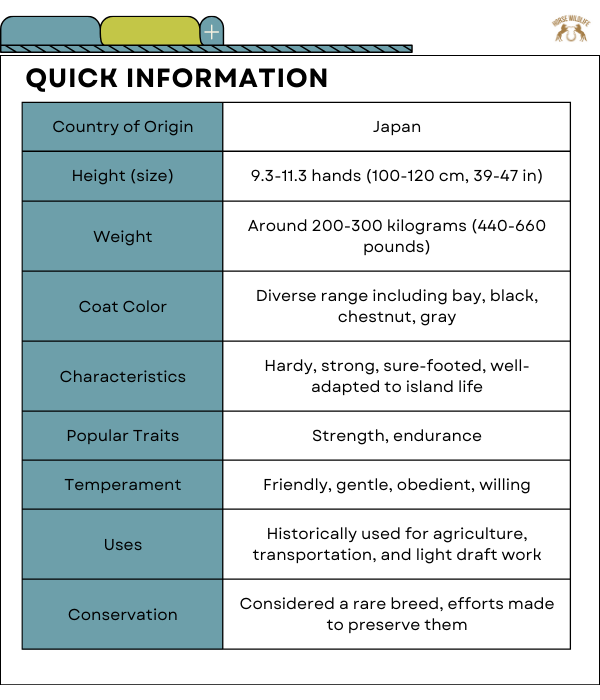The Tokara Pony, often referred to as the Kagoshima Pony, represents a breed of modestly sized ponies originating from the serene Tokara Islands in Kagoshima Prefecture, Japan. Distinguished by their exceptional tolerance to warm climates, these ponies have historically been a versatile asset, adept in both equestrian pursuits and agricultural labor.
Quick Information

This introduction seeks to explore the unique characteristics and heritage of the Tokara Pony, underscoring its importance in the socio-cultural fabric and agricultural history of its native islands.
History:
The Tokara Pony, also known as Kagoshima Pony, first surfaced in 1952 on Takarajima Island of Tokara Archipelago by Professor Shigeyuki Hayashida of Kagoshima University.
This event signaled its formal recognition. According to current theory, these ponies may have first arrived from Kikaijima sometime around early 1900s.
1953 saw their discovery and official designation as a natural monument of Kagoshima Prefecture; thus honoring their significance and rarity.
Professor Hayashida first documented these ponies when Professor Hayashida observed 43; however, their numbers gradually diminished throughout the 1960s due to mechanized agriculture that reduced traditional roles they once filled.
Due to population decline and logistical difficulties associated with monitoring horses on a remote island, an important decision was made; some Tokara Ponies were moved from Mt. Kaimon Natural Park and Iriki Farm associated with Kagoshima University’s agricultural department to more manageable settings like Mt. Kaimon Natural Park and Iriki Farm associated with Kagoshima University agricultural department for care, study, breeding purposes as a measure for their preservation. This move ensured their survival as an equine breed lineage will continue in perpetuity over time.
Physical Characteristics:
Size and Build: Tokara Ponies are small ponies, typically standing 10-12 hands high. Yet despite their diminutive stature, these animals are known for having sturdy yet muscular bodies to help adapt them to life on an island homestead.
Coat and Color: Island goats have various coat colors, such as bay, black, and chestnut. Their thick fur helps them adapt to the unpredictable climate conditions on these islands.
Behavior and Temperament:
Adaptability: Tokara ponies are famed for their adaptability and resilience – traits fostered by living on one of their challenging islands, Tokara.
Temperament: They are known for being extremely gentle, intelligent and friendly – qualities which make them suitable for various forms of equestrian activities beyond traditional roles.


Conservation and the Current status:
Endangered Status: The Tokara Pony breed is now considered endangered due to modernization and declining traditional uses for them.
Conservation Initiatives: Japan has ongoing conservation initiatives underway in order to preserve this breed of pony.
This includes breeding programs and initiatives to integrate Tokara Ponies into modern equestrian activities as well as cultural and educational initiatives.
The Tokara Pony in Modern Times:
Cultural Integration: Festivals and events celebrating Tokara Ponies serve to raise awareness about their breed and cultural significance.
Equestrian Activities: These gentle horses have increasingly become used in therapeutic riding programs as mounts for children due to their mild temperament.

